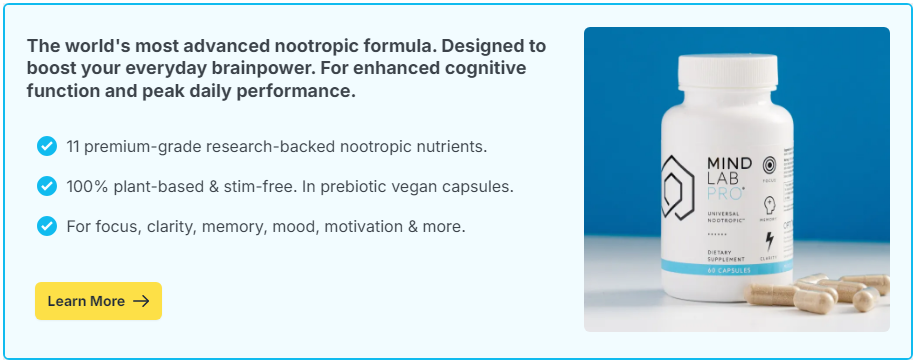
Mistakes are often viewed as failures – evidence that we are not skilled, careful, or smart enough. But from your brain’s perspective, errors are golden opportunities. Each wrong turn, incorrect guess, or flawed assumption can strengthen your neural networks, improve your adaptability, and expand your problem-solving skills. This capacity for the brain to reshape itself in response to experiences, known as neuroplasticity, thrives on trial, error, and correction.
The truth is, avoiding mistakes entirely limits growth. By leaning into your errors and understanding the science behind them, you can reframe them as stepping stones to higher cognitive performance.
Contents
- Neuroplasticity: Your Brain’s Adaptation Engine
- The Error-Driven Learning Loop
- Why Mistakes Stick in Memory
- The Productive Mistake Zone
- Turning Errors into Cognitive Fuel
- How Nootropics and Brain Health Support Learning from Mistakes
- Real-World Examples of Error-Driven Growth
- Reframing Your Relationship with Mistakes
- From Misstep to Mastery
Neuroplasticity: Your Brain’s Adaptation Engine
Neuroplasticity is the brain’s ability to reorganize itself by forming new neural connections. These connections change based on what you do, think, and experience. When you make a mistake, your brain detects a mismatch between what you expected to happen and what actually occurred. This “prediction error” triggers adjustments in the neural circuits involved, making them more accurate next time.
For example, if you miscalculate a math problem, neurons in regions responsible for numerical processing adjust their firing patterns to improve your next attempt. Over time, these adjustments create stronger, more efficient pathways.
The Error-Driven Learning Loop
Learning from mistakes follows a loop:
- Attempt: You try to solve a problem or perform a task.
- Feedback: You discover whether your attempt was correct or not.
- Adjustment: The brain refines its approach based on feedback.
- Reattempt: You try again, applying the updated strategy.
This loop is common in everything from language acquisition to sports performance. Each pass through the cycle strengthens relevant neural circuits, even if improvement is gradual.
Why Mistakes Stick in Memory
Errors are often emotionally charged – frustration, surprise, or even mild embarrassment. These emotions activate the amygdala, which flags the event as important. The hippocampus then works harder to encode it, ensuring the lesson is easier to recall later. This is why the mistakes you make when first learning a skill often become mental landmarks in your memory.
The Productive Mistake Zone
Not all mistakes are equally useful. The most beneficial ones occur when you are working just beyond your current skill level – challenging enough to stretch your abilities, but not so hard that you are completely lost. This “productive mistake zone” maximizes neuroplasticity because it pushes the brain to adapt without overwhelming it.
Turning Errors into Cognitive Fuel
To get the most out of mistakes, you can:
- Analyze, don’t dwell: Instead of replaying the error emotionally, focus on what caused it and how to correct it.
- Seek immediate feedback: The sooner you know what went wrong, the more effectively your brain can adjust.
- Experiment deliberately: Try different strategies, even if they might fail, to widen your problem-solving toolkit.
- Celebrate progress: Recognize when a past mistake has led to measurable improvement.
How Nootropics and Brain Health Support Learning from Mistakes
Brain plasticity depends on healthy neurons and robust communication between them. Sleep, nutrition, and physical exercise all contribute to the brain’s ability to adapt. Some people also use nootropics and brain supplements to support neurotransmitter function, attention, and memory formation. While supplements will not prevent mistakes, they may enhance your brain’s responsiveness to feedback, making error-based learning more efficient.
Real-World Examples of Error-Driven Growth
- Musicians: A wrong note during practice can help a pianist refine finger placement and timing.
- Athletes: Missing a shot forces a basketball player to adjust stance, grip, or aim.
- Writers: Editorial feedback on awkward phrasing can sharpen clarity and style.
- Students: Incorrect answers on practice tests reveal specific knowledge gaps to address.
Reframing Your Relationship with Mistakes
If you view mistakes as failures, you are likely to avoid risk and limit your learning potential. But if you see them as data points for improvement, you create a growth-friendly mental environment. Every error becomes an investment in your brain’s adaptability, paving the way for more skillful and confident performance in the future.
From Misstep to Mastery
The path to mastery is rarely smooth – it is marked with wrong turns, flawed attempts, and surprising results. Each of these moments shapes the brain, adding folds and connections that make it more capable. By embracing mistakes as a necessary part of growth, you can turn them into one of your most powerful tools for building intelligence, skill, and resilience.

